To protect your datacenter from harmful electrical discharge, you'll need multiple integrated tools working together. Start with conductive or static dissipative flooring that safely channels static to ground. Install antistatic mats and wrist straps at workstations, and make certain all personnel use proper ESD-control footwear. Deploy surge protection devices and UPS systems to guard against power anomalies. Maintain strict environmental controls, keeping humidity between 40-55% and temperature between 64-80°F. Regular testing of all ESD equipment and monitoring of electrical systems is vital. These fundamentals are just the beginning of a complete static defense strategy.
Static Control Floor Systems
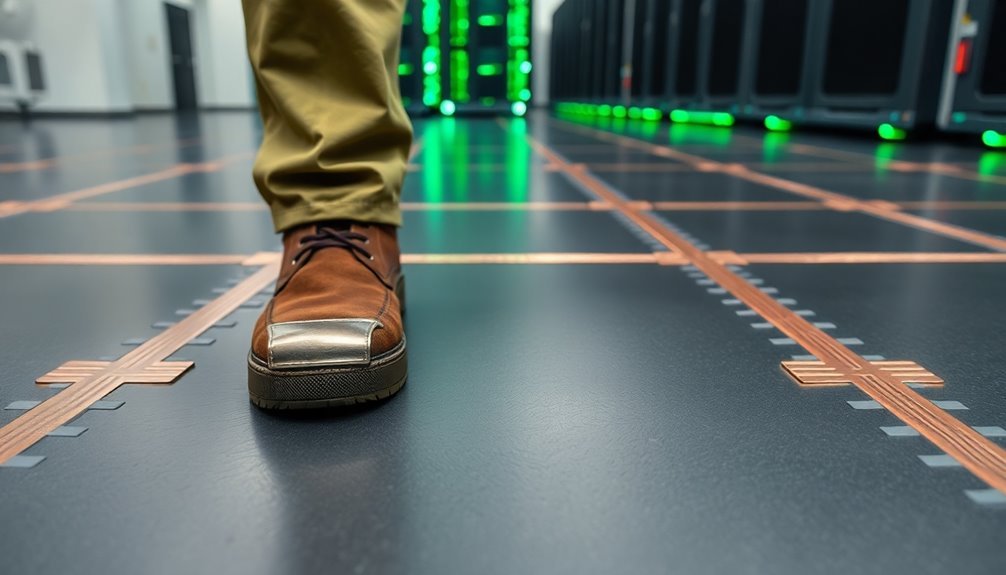
In and around modern data centers, static control floor systems play a vital role in preventing electrical discharge incidents. You'll find two main types: conductive flooring and static dissipative flooring, each serving specific protection needs. Personnel working in these areas must follow strict protocols since ESD can damage components with discharges as low as 10 volts.
Conductive flooring offers resistance less than 1 million Ohms and features embedded conductive filaments that create a direct path to ground. You won't need special polish or wax, as the conductivity is built into the material.
Static dissipative flooring, with resistance between 1 million and 1 billion Ohms, allows charges to flow more slowly and typically requires conductive polish for best performance.
When you're selecting a floor system, you'll need to evaluate several critical factors. Your floor must be ground-able, maintain permanent static-resistant properties, and withstand heavy equipment impacts.
You should also account for environmental conditions, as humidity levels affect static control effectiveness. The floor's surface must remain seamless and dustproof for easy maintenance.
To guarantee proper protection, you'll want to consult with facility experts to determine the ideal resistance range for your specific needs. Remember that both your flooring choice and installation method must align with your data center's precise static control requirements.
Essential ESD Safety Equipment
To protect your sensitive datacenter equipment from static electricity, you'll need to equip your workspace with antistatic mats and grounded wrist straps at each workstation.
You should connect these essential ESD tools to your facility's ground point, ensuring a safe discharge path for static electricity away from critical components. Regular ESD safety audits must be performed to verify all protective equipment remains functional and compliant with international standards.
While antistatic mats provide immediate workspace protection, you'll also want to think about installing conductive flooring systems throughout your facility to create a thorough static-control environment.
Antistatic Mats and Wriststraps
Two essential pieces of ESD safety equipment protect data center components from harmful static discharge: antistatic mats and wrist straps.
Antistatic mats control static electricity buildup through moderate electrical resistance, allowing charges to dissipate gradually rather than discharge suddenly. You'll find these mats don't typically need grounding, making them a cost-effective solution for environments with lower ESD risks. These mats are constructed with conductive rubber materials to minimize static buildup effectively.
When you're handling sensitive equipment, you must pair your antistatic mat with an ESD wrist strap. These wrist straps, made from conductive materials like metal threads or carbon fibers, safely channel static electricity from your body to a grounded surface.
You'll need to guarantee your wrist strap is properly grounded and regularly verified for functionality to meet ANSI/ESD S20.20 standards.
Together, these tools create a thorough ESD protection system. You'll benefit from reduced equipment damage, lower repair costs, and enhanced workplace safety. The mats provide a static-free work surface, while wrist straps protect components during direct handling.
When you're working in data centers, both tools are vital for maintaining equipment reliability and preventing costly disruptions to service delivery.
Conductive Flooring Systems
Numerous data centers rely on conductive flooring systems as a critical line of defense against electrostatic discharge. You'll find two main types: conductive flooring, with resistivity between 1,000 and 1 million ohms, and dissipative flooring, ranging from 1 million to 1 billion ohms. While conductive flooring costs more, it's more effective at preventing static charges above 500 volts.
When you're selecting a flooring system, you'll need to assess your facility's specific requirements. Consider factors like foot traffic, activities performed, and the sensitivity of your equipment. These systems are engineered with conductive particles and fibers that create pathways for static discharge.
ASHRAE research supports using at least moderately conductive flooring in controlled areas, as it can reduce the need for humidification and lead to energy savings.
Before installation, you'll want to prepare surfaces properly, removing old coatings and repairing damage. Remember to test the flooring's performance under various humidity conditions and with different types of ESD footwear.
You should also guarantee compliance with industry standards like ANSI/ESD STM 7.1. The right conductive flooring system won't just protect your sensitive equipment—it'll also enhance safety by preventing static sparks in potentially hazardous environments.
Personnel Grounding Devices
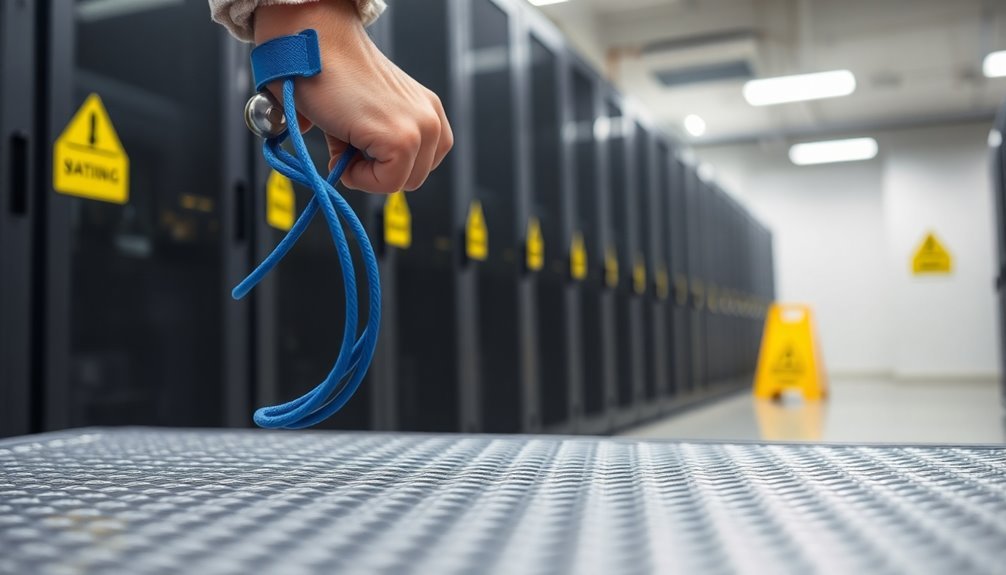
You'll need to follow strict wrist strap protocols, including daily testing and proper skin contact, to maintain effective grounding while working with sensitive datacenter equipment.
Your ESD-control footwear must meet minimum resistance requirements and be tested before each shift to guarantee proper static dissipation through flooring systems.
When connecting grounding cables, you should always verify secure attachments to both the wrist strap and the common ground point, guaranteeing the cord isn't stretched or tangled.
The connection to the central grounding bus bar system ensures all personnel grounding devices maintain a reliable path to ground.
Wrist Strap Safety Protocols
Maintaining proper wrist strap protocols stands as a critical defense against electrostatic discharge in data center environments. You'll need to confirm that your wrist strap contains conductive materials like metal threads or carbon fibers and connects properly to a designated grounding point through an anti-static coiled cord. Regular inspection for damage is essential to ensure your wrist strap continues functioning effectively.
When you're working in the data center, you must verify that your wrist strap fits securely and comfortably, as you'll likely wear it for extended periods. Some advanced models will indicate if you've established a proper connection to the grounding point, which helps maintain continuous protection.
Don't overlook the importance of connecting to a common ground point, especially in areas like manufacturing floors, work benches, and clean rooms. You'll need to be particularly careful in facilities with flammable gases, where grounding requirements are more stringent.
Remember that wireless wrist straps won't meet ANSI/ESD S20.20 standards, so you can't use them in ESD-controlled areas. Additionally, never use these straps when working with high-voltage equipment, as they can pose a safety hazard.
Before entering ESD-protected areas, you must verify your grounding system's functionality to confirm proper protection.
Static-Free Footwear Requirements
While wrist straps provide personal grounding at workstations, proper ESD footwear creates continuous protection as you move throughout the data center. You'll need to select footwear that forms a safe pathway to ground and matches your facility's flooring material to prevent static buildup effectively.
Your ESD footwear options include heel straps, toe straps, sole straps, and specialized ESD shoes. Heel straps work by creating an electrical bond with conductive floor fibers, while sole straps offer fuller coverage across your shoe's bottom surface.
If you're working in high-protection areas, you'll want to think about dedicated ESD shoes. Tests at different voltages help determine if your footwear meets compliance requirements.
You must guarantee your chosen footwear meets ANSI/ESD S20.20 standards, which require static generation to stay below 100 volts in electronics handling areas. The type of sole material matters substantially – PVC soles generate more static than leather ones, so you'll need to factor this into your selection.
When you're implementing static control measures, remember that your ESD footwear must work in tandem with your facility's flooring system. This combination helps you maintain consistent protection and prevents costly equipment damage while moving through the data center.
Grounding Cable Best Practices
Proper grounding cable installation serves as your primary defense against electrical hazards and equipment damage in the data center. You'll need to guarantee all metal components connect to a central grounding system through a properly sized, low-resistance path.
This comprehensive approach reduces electromagnetic interference that could otherwise disrupt sensitive equipment operations.
Start by installing a thorough grounding grid with interconnected conductors and connect it to copper bus bars that serve as central connection points.
When implementing your grounding system, you'll want to use high-quality copper or copper-clad steel ground rods driven into the earth. Connect all equipment frames and enclosures to this system using appropriate connectors and hardware.
Don't forget to include supplemental grounding for HVAC systems and static-sensitive areas.
For personnel safety, you must maintain a common ground point that connects to your main grounding conductor. Install ESD protection devices like wrist straps and dissipative work mats at workstations.
If you're working in a clean room environment, you'll need specialized solutions such as ESD floors and conductive footwear.
Remember to conduct regular inspections and testing to verify your grounding system's integrity, and always follow TIA-942 standards for maximum network availability and equipment protection.
Workstation Protection Solutions
The implementation of workstation protection solutions serves as a crucial defense against electrical discharge threats in modern datacenters. You'll need to deploy multiple layers of protection to safeguard your workstations and keep them safe and operational.
Start with Surge Protection Devices (SPDs) that comply with UL 1449 and IEEE C62.41 standards. You'll want to install these at your electrical panels and near critical equipment to absorb voltage spikes effectively.
Make sure you're regularly inspecting and replacing these devices to maintain their protective capabilities.
Your grounding system needs to provide a low-impedance path that safely channels electrical discharges away from sensitive equipment. You should verify it meets NFPA 70 and IEEE 80 requirements, and don't forget to test it regularly to verify its integrity.
You'll also need to implement UPS systems to maintain continuous power and filter harmful surges. Choose between online, offline, or line-interactive systems based on your specific needs.
Complete your protection strategy with electrical isolation systems, including isolation transformers and surge arresters that comply with UL 60065 and IEEE C37.20.7 standards.
Remember to regularly test all components to verify they're functioning as intended.
Environmental Control Measures
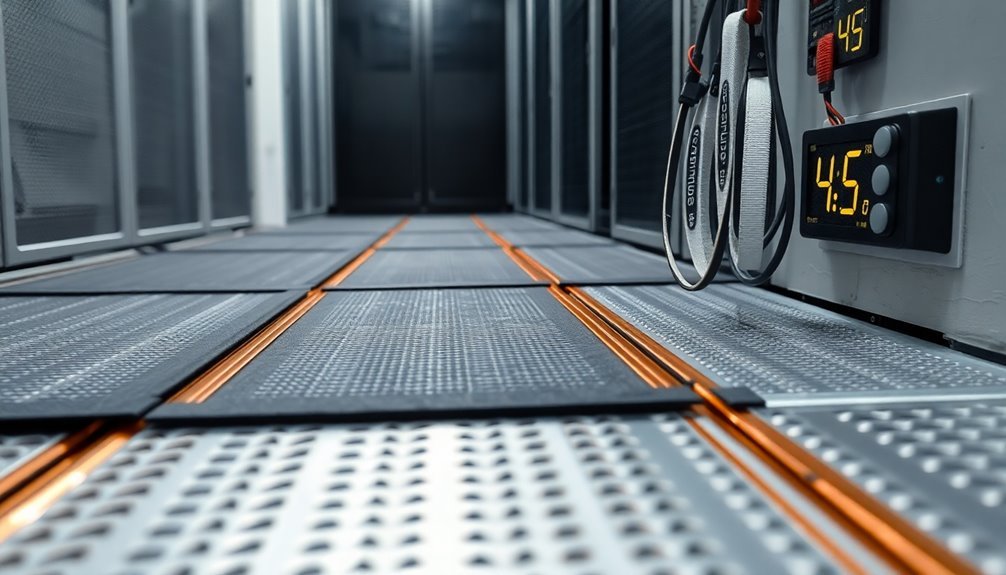
Inside modern datacenters, environmental control measures work together to maintain ideal conditions for equipment operation and safety.
Temperature controls keep the environment between 64.4°F and 80.6°F through chillers and strategic airflow management, which helps prevent hardware failures and improves energy efficiency.
Humidity control is equally critical, as you need to maintain relative humidity between 40% and 55% to prevent static electricity buildup. When conditions become too dry, you'll face increased risks of static discharge, which can damage sensitive IT components with voltages under 25 volts. That's why you'll see moisture sensors and continuous monitoring systems throughout the facility.
Your datacenter's electrical monitoring system includes energy monitors that detect static electricity buildup and implement automatic responses to protect equipment. You'll need to integrate these with thorough security measures, including fire suppression systems and intrusion detection.
The combination of clean agents, dry pipe sprinklers, and advanced sensors creates multiple layers of protection. Remote monitoring solutions let you track these environmental conditions in real-time, allowing for immediate response to any deviations that could lead to harmful electrical discharge.
Common Static Sources
Building upon these environmental controls, you'll need to identify and address common static electricity sources in your datacenter. The most prevalent source comes from human interaction, as your personnel's movement across floors and contact with equipment can generate substantial static buildup.
When staff members walk on non-ESD flooring or handle materials with different resistance levels, they're likely to accumulate static charges that can discharge into sensitive equipment.
Material interactions present another critical concern. You'll find static electricity develops when different materials slide against each other or separate, particularly in low-humidity environments. This includes routine activities like removing packaging materials or sliding equipment across surfaces.
Your datacenter's environmental conditions can markedly impact static formation, especially when relative humidity drops below recommended levels.
To combat these sources, you'll want to implement thorough static control measures. Install ESD or conductive flooring to help dissipate charges, and guarantee your staff uses proper grounding equipment when handling sensitive components.
Maintain appropriate humidity levels through your air conditioning system, and require personnel to use ESD-protective clothing and workstations. Regular equipment maintenance and inspection will help identify potential static-generating issues before they cause damage.
Monitoring and Testing Tools
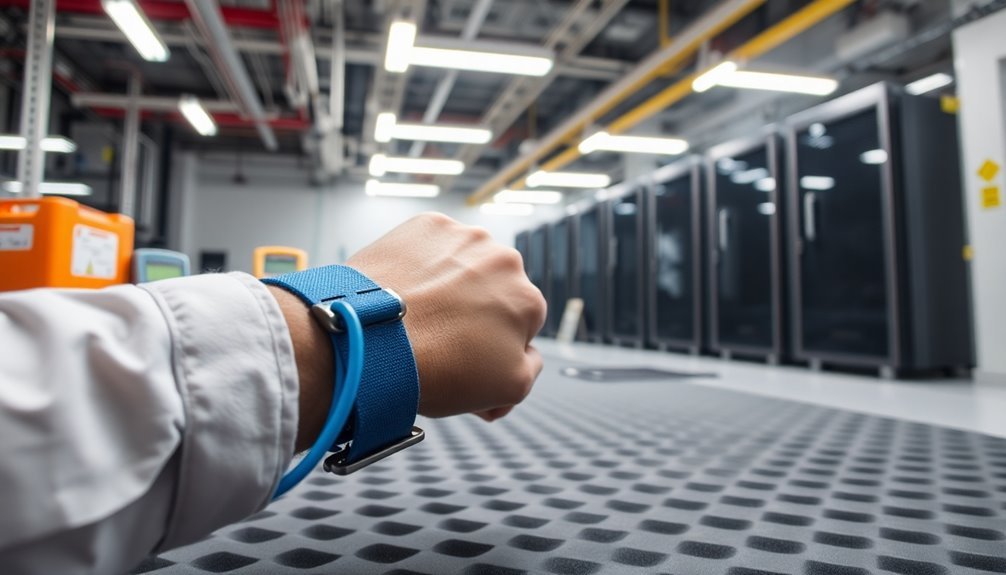
Modern datacenter operations depend heavily on sophisticated monitoring and testing tools to prevent electrical discharge incidents. You'll find extensive power monitoring systems that track distribution patterns and identify potential discharge risks through real-time surveillance of voltage levels and current fluctuations.
These systems integrate with environmental sensors to maintain ideal conditions and prevent static buildup.
Key monitoring and testing capabilities include:
- PDU-level tracking that monitors power consumption at individual outlets, helping you identify unusual electrical patterns that might indicate discharge risks
- Environmental monitoring systems that track temperature, humidity, and other conditions that could contribute to static electricity accumulation
- High-level infrastructure monitoring of transformers and breakers, allowing you to detect and address potential discharge points before they become problematic
- Real-time visualization tools that provide instant alerts when electrical parameters deviate from safe ranges
Through these monitoring tools, you'll gain actionable insights into your facility's electrical behavior. Advanced analytics help you spot trends and anomalies that could lead to discharge events, while integration with various hardware vendors guarantees thorough coverage across your entire infrastructure.
This systematic approach to monitoring substantially reduces the risk of harmful electrical discharge events.
Preventive Maintenance Protocols
Effective preventive maintenance protocols serve as your first line of defense against electrical discharge events in datacenters. You'll need to implement thorough maintenance schedules that cover all critical systems while documenting every activity for accountability and compliance.
| System Component | Maintenance Action | Frequency |
|---|---|---|
| UPS Batteries | Load testing & inspection | Monthly |
| Power Generators | Operational testing | Quarterly |
| Air Filtration | Clean/replace filters | Bi-monthly |
| Static Controls | Test & calibrate | Weekly |
You'll want to leverage IoT sensors and monitoring software to track key performance metrics in real-time. These tools help you identify potential issues before they escalate into serious problems. Make sure you're following standardized checklists for each maintenance procedure to maintain consistency across your operations.
Don't forget to partner with professional service providers who understand datacenter-specific requirements. They'll help guarantee your maintenance practices align with industry standards and compliance requirements. Regular IR scans should be part of your protocol to identify potential weak spots in equipment, while anti-static cleaning tools must be used during all maintenance activities to protect sensitive electronics from discharge damage.
Cost-Effective Static Prevention Strategies
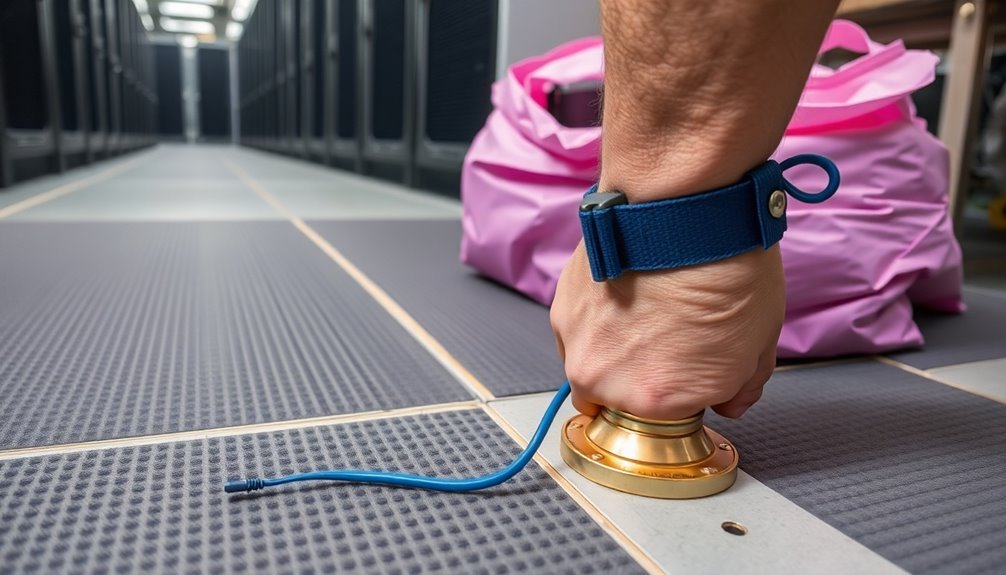
A strategic approach to static prevention doesn't have to drain your datacenter's budget. You'll find that many cost-effective solutions can protect your equipment while maintaining operational efficiency. By focusing on humidity control and basic grounding techniques, you can substantially reduce the risk of electrostatic discharge without major capital investments.
Start with these proven, budget-conscious strategies:
- Implement basic humidity monitoring systems to maintain RH levels above 50%, using affordable sensors that connect to your existing management software.
- Invest in reusable anti-static equipment like wrist straps and ESD mats, which offer long-term protection at a minimal upfront cost.
- Optimize resource utilization through virtualization to reduce the number of physical devices requiring static protection.
- Adopt sustainable practices such as TPM services and refurbished parts to lower your overall maintenance expenses.
You can further reduce costs by automating routine static prevention tasks and leveraging predictive analytics to anticipate potential issues before they arise.
Remember to train your staff on proper grounding techniques and ESD prevention protocols – it's an inexpensive yet effective way to protect your valuable equipment and maintain operational continuity.
Frequently Asked Questions
How Often Should ESD Protection Equipment Be Tested and Recalibrated?
You'll need to test worksurfaces quarterly, wrist straps daily, and continuous monitors semi-annually. Your exact testing schedule should align with your ESD control plan and consider product sensitivity and environmental factors.
Can Wireless Devices Interfere With ESD Protection Systems?
Yes, your wireless devices can interfere with ESD protection systems. Their antennas and RF circuits are particularly vulnerable to ESD events, requiring careful selection of protection diodes to maintain both signal quality and safety.
What Certifications Should ESD Protection Specialists Have?
You'll want to obtain iNARTE ESD Engineer Certification and guarantee facility compliance with ANSI/ESD S20.20 and IEC 61340-5-1 standards. These credentials demonstrate your expertise in implementing effective ESD protection measures.
Are There Specific Cleaning Products Safe for Esd-Protected Areas?
Yes, you'll need specially designed ESD-safe cleaning products that don't generate static electricity. Use cleaners, lotions, and coatings specifically labeled for ESD-protected areas to maintain ANSI/ESDS20.20 compliance and prevent component damage.
How Do Temperature Fluctuations Affect ESD Protection Effectiveness?
You'll notice decreased ESD protection as temperatures rise, with first breakdown voltage dropping 27.32% and holding voltage falling 8.49%. This makes your devices more vulnerable to static discharge during warmer conditions.
In Summary
You've got multiple layers of protection at your disposal to prevent harmful static discharge in your datacenter. From specialized floor systems and personal grounding devices to environmental controls and testing equipment, you're well-equipped to safeguard sensitive electronics. Don't forget to maintain these systems regularly and train your staff properly. With these tools in place, you'll minimize the risk of costly ESD damage.





Leave a Reply